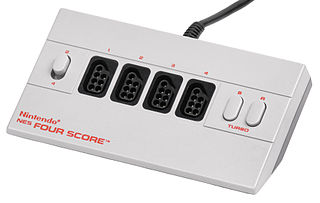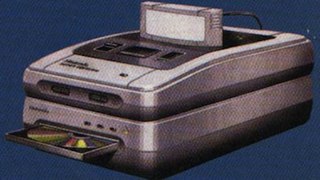
The Super Nintendo Entertainment System (SNES), commonly shortened to Super NES or Super Nintendo, is a 16-bit home video game console developed by Nintendo that was released in 1990 in Japan and South Korea, 1991 in North America, 1992 in Europe and Oceania, and 1993 in South America. In Japan, it is called the Super Famicom (SFC). In South Korea, it is called the Super Comboy and was distributed by Hyundai Electronics. The system was released in Brazil on August 30, 1993, by Playtronic. Although each version is essentially the same, several forms of regional lockout prevent cartridges for one version from being used in other versions.

The Family Computer Disk System, commonly shortened to the Famicom Disk System or just Disk System, is a peripheral for Nintendo's Family Computer home video game console, released only in Japan on February 21, 1986. It uses proprietary floppy disks called "Disk Cards" for cheaper data storage and it adds a new high-fidelity sound channel for supporting Disk System games.

The New-Style NES is a compact cost-reduced redesigned version of the Nintendo Entertainment System released by Nintendo in 1993.

The Super Game Boy is a peripheral that allows Game Boy cartridges to be played on a Super Nintendo Entertainment System console. Released in June 1994, it retailed for $59.99 in the United States and £49.99 in the United Kingdom. In South Korea, it is called the Super Mini Comboy and was distributed by Hyundai Electronics.

The New-Style Super NES is a compact redesign of the original Super Nintendo Entertainment System home video game console released by Nintendo in 1997. In Japan, the system is called the Super Famicom Jr.. Like the redesigned version of the original Nintendo Entertainment System before it, the new-style Super NES was released late during the platform's lifespan.

The NES Four Score is a multitap accessory created by Nintendo in 1990 for the Nintendo Entertainment System. Select games can utilize it to enable up to four-player gameplay. The NES Four Score is similar to the previously introduced NES Satellite, a device that allows four players to connect to the NES and extends the range using infrared wireless communication.
A famiclone is a colloquial name given to any clone console of the Nintendo Entertainment System (NES), known in Japan as the Family Computer or Famicom. They are electronic hardware devices designed to replicate the workings of, and play games designed for, the NES and Famicom. Hundreds of unauthorized clones and unlicensed copies have been made available since the height of the NES popularity in the late 1980s. The technology employed in such clones has evolved over the years: while the earliest clones feature a printed circuit board containing custom or third party integrated circuits (ICs), more recent (post-1996) clones utilize single chip designs, with a custom ASIC which simulates the functionality of the original hardware, and often includes one or more on-board games. Most devices originate in China and Taiwan, and less commonly South Korea.

The Super FX is a coprocessor on the Graphics Support Unit (GSU) added to select Super Nintendo Entertainment System (SNES) video game cartridges, primarily to facilitate advanced 2D and 3D graphics. The Super FX chip was designed by Argonaut Games, who also co-developed the 3D space rail shooter video game Star Fox with Nintendo to demonstrate the additional polygon rendering capabilities that the chip had introduced to the SNES.
The Tristar 64 is an unlicensed add-on for the Nintendo 64 (N64) video game console. Produced in Hong Kong by Future Laboratory, the Tristar 64 features two additional cartridge ports which are designed to accept cartridges created for the Nintendo Entertainment System and Super Nintendo Entertainment System. The device then emulates the NES or SNES hardware, and allows the cartridge to be run. The device also features built-in cheat cartridge functionality through a program called the X-Terminator, as well as the Memory Editor, which allows SRAM and EEPROM saved game data to be archived and edited.
A multitap is a video game console peripheral that increases the number of controller ports available to the player, allowing additional controllers to be used in play, similar to a USB hub or a power strip. A multitap often takes the form of a box with three or more controller ports which is then connected to a controller port on the console itself.
A video game accessory is a distinct piece of hardware that is required to use a video game console, or one that enriches the video game's play experience. Essentially, video game accessories are everything except the console itself, such as controllers, memory, power adapters (AC), and audio/visual cables. Most video game consoles come with the accessories required to play games out of the box : one A/V cable, one AC cable, and a controller. Memory is usually the most required accessory outside of these, as game data cannot be saved to compact discs. The companies that manufacture video game consoles also make these accessories for replacement purposes as well as improving the overall experience. There is an entire industry of companies that create accessories for consoles as well, called third-party companies. The prices are often lower than those made by the maker of the console (first-party). This is usually achieved by avoiding licensing or using cheaper materials. For the mobile systems like the PlayStation Portable and Game Boy iterations, there are many accessories to make them more usable in mobile environments, such as mobile chargers, lighting to improve visibility, and cases to both protect and help organize the collection of system peripherals to. Newer accessories include many home-made things like mod chips to bypass manufacturing protection or homemade software.

The Japanese multinational consumer electronics company Nintendo has developed seven home video game consoles and multiple portable consoles for use with external media, as well as dedicated consoles and other hardware for their consoles. As of September 30, 2021, in addition to Nintendo Switch, Nintendo has sold over 863.07 million hardware units.
Nintendo 64 accessories include first-party Nintendo hardware—and third-party hardware, licensed and unlicensed. Nintendo's first-party accessories are mainly transformative system expansions: the 64DD Internet multimedia platform, with a floppy drive, video capture and editor, game building setup, web browser, and online service; the controller plus its own expansions for storage and rumble feedback; and the RAM-boosting Expansion Pak for big improvements in graphics and gameplay. Third-party accessories include the essential game developer tools built by SGI and SN Systems on Nintendo's behalf, an unlicensed SharkWire online service, and unlicensed cheaper counterparts to first-party items. The Nintendo 64 video game console had a market lifespan from 1996 to 2002.

The Nintendo Entertainment System (NES) is an 8-bit third-generation home video game console produced by Nintendo. It was first released in Japan in 1983 as the Family Computer (FC), commonly known as the Famicom. The NES, a redesigned version, was released in American test markets in October 1985, before becoming widely available in the rest of North America and other countries.

The Retro Duo is a handheld game console developed by Retro-Bit and distributed by Innex, Inc. It plays game cartridges for the Nintendo Entertainment System and Super Nintendo Entertainment System. It plays North American, European and Japanese games and has the highest compatibility of any other clone system. S-video is compatible when playing SNES games. The console is not licensed by Nintendo and it’s not fully compatible with every game released for the two game systems; however, the majority of games function properly. While it has only been released in Canada and the United States, it can still be used in Europe and Japan with a power plug adapter. The console is compatible with official and third party SNES controllers.

The Super NES CD-ROM System, known as Super Famicom CD-ROM Adapter in Japan, is an unreleased video game peripheral for the Super Nintendo Entertainment System (SNES). The add-on built upon the functionality of the cartridge-based SNES by adding support for a CD-ROM-based format known as Super Disc.
The RetroN is a series of video game consoles created and developed by Hyperkin which allows users to play old video games from consoles such as the Nintendo Entertainment System and the Super NES. Since the release of the RetroN 5, they have been connected via HDMI. The latest in the series, RetroN Sq, was released in 2021.

The Super NES Classic Edition is a dedicated home video game console released by Nintendo, which emulates the Super Nintendo Entertainment System. The console, a successor to the NES Classic Edition, comes with twenty-one Super NES titles pre-installed, including the first official release of Star Fox 2. It was released in North America and Europe on September 29, 2017.

The Analogue Super Nt is an FPGA-based home video game console designed and manufactured by Analogue, Inc., It is designed to be compatible with games for the Super Nintendo Entertainment System.















